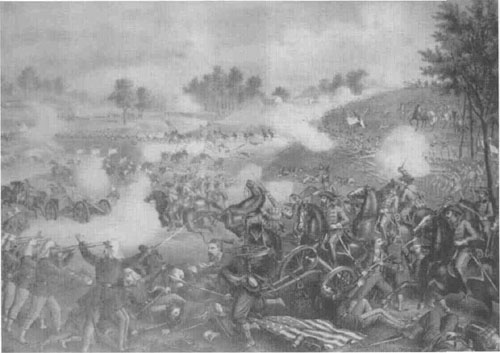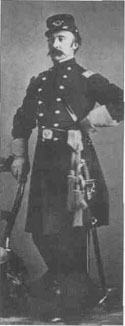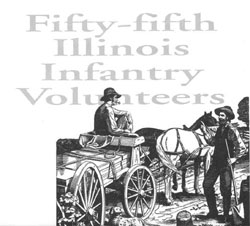 |
Home | Search | Browse | About IPO | Staff | Links |
 |
Home | Search | Browse | About IPO | Staff | Links |
David Pasquini
Main Ideas
Connection with the Curriculum
17
having students work with primary sources and draw conclusions from the information contained in the primary sources.
Teaching Level
Materials for Each Student
• A copy of the narrative portion of this article
Objectives for Each Student
• Analyze the differing attitudes towards the start of the Civil War and decide why northerners decided to fight the attempt by the South to create an independent nation.
Opening the Lesson

18 comments can be copied by the students. Allow ten or fifteen minutes for discussion. Then instruct students to construct a hypothesis of a couple sentences that represents their best explanation for why people decided to fight. To simplify the process, instruct the students to concentrate on explaining why northerners decided to fight. Distribute Handout 1. Assign the map for homework or as an in-class activity prior to undertaking the following discussion. Review the location of the required items to ensure that students can locate important places, rivers, and other points prior to reading the narrative portion of this article. In reviewing this assignment with Handout 1, help students understand that Illinois was strategically located; it was like a dagger pointed into the heart of the Confederacy. Using a map of the United States, identify Cairo, Illinois, and compare its location to Richmond, Virginia. Just how far Illinois extended southward may surprise some students. The numerous rivers, especially the Ohio and Mississippi, would be critical invasion routes both into the South and the North. The rivers would also be important for transporting troops and supplies. The critical point is that Illinois, for geographical and economic reasons, would be much concerned and affected by any war that pitted North against South. Help students speculate how different parts of Illinois might react to the news of war. Help students understand that people from Kentucky, Tennessee, and other southern states settled the deep southern part of the state and that new Englanders settled many parts of northern Illinois. The geographical length of the state tended to intensify differing perspectives of North and South. Point out that the population of the state was much more evenly distributed than at present. Illinois' population boomed between 1850 and 1860. By 1860, the state boasted a population of 1,711,961. The major urban areas were Chicago, Peoria, Galena, Alton, Quincy, Freeport, and Rock Island. Foreign immigration increased, especially in the urban areas. Illinois counted 7,628 free African Americans among its citizens. With such diversity, differences of opinion about the crucial issues of the day would be most likely. With a basic comprehension that Illinois could not dodge involvement in the Civil War, coupled with a brief overview of how different settlement trends would lead to differing opinions about the issues surrounding the start of the war, the students are ready to participate in a recruiting rally.
Developing the Lesson
• Distribute Handout 2. Explore how the attitudes in the poem may have changed at various times in the war-- in April 1861 with the news of the attack on Fort Sumter; after the news of bloody Shiloh in April 1862 (Illinois contributed 28 of 65 Union regiments and accounted for more than one-third of the total loss of 13,047 killed, wounded, and missing); when the Emancipation Proclamation went into effect in January 1863; upon reports that Sherman's bummers (which referred to soldiers foraging off the land) had taken Savannah in early December, 1864; and, in late April, 1865, with news that the war was over upon Johnston's surrender to Sherman. • Distribute Handouts 3 and 4 and make sure that students understand what is expected of them during the recruiting rally. Assign roles of specific men using Handout 5, and explain the role play. The purpose of the role play is to discuss what should be done in reaction to the news of Fort Sumter. Who will enlist and why? Who will stay home and why? For the purpose of the role play, all participants will play males. However, roles can be modified in the role play to include female roles. If female roles are added, then an additional question to be debated at the role play is the place of women in the war. • Explain that the time of the role play is shortly after news has arrived that the rebels have taken Fort Sumter. President Lincoln has issued his call tor "the militia of the several States of the Union, to the number of seventy-five thousand" to put down the insurrection. The teacher may want to have the students construct posters reacting
19
to the news of the firing on Fort Sumter. (Models can be found in any number of picture books on the Civil War). Have the room set up as a town square. (Place desks around the edge of the room leaving the center of the room open). Have the posters up on the wall. For additional effect, the teacher may have Civil War music playing as students enter the room to participate in the role play. The teacher should serve as the mayor of the town to guide the discussion. To spark discussion, the teacher may want to play the role of a Copperhead opposed to supporting Lincoln's call to put down insurrection.
Concluding the Lesson
Extending the Lesson
• Students can pursue individual research into their Civil War ancestors, or they can research the role of the individual for the role play. Refer to Tracing Your Civil War Ancestor by Bertram H. Groene.
Assessing the Lesson
20
Locate the following on the map below: Chicago, Watseka, Kankakee, Onarga, Glenview, Ashkum, Loda, Cairo, Bloomington, Carbondale, Centralia, Peoria, Galena, Rock Island, Springfield, St. Louis (Missouri), Lake Michigan, Mississippi River, Illinois River, Ohio River, Wabash River, and the Illinois and Michigan Canal.

21
Handout 2 -- A Civil War Poem
Richard W. Burt was a veteran of both the Mexican and the Civil Wars. After the Civil War he lived in Peoria, Illinois, until he died on July 8,1911. Burt enlisted in the Civil War, and according to his obituary "served throughout the war and was a gallant soldier." In March 1864 he was promoted to the rank of captain. Despite a wound received at Resaca, Georgia in May 1864, Burt remained in the service until his unit was mustered out on July 15,1865. According to Burt's obituary in a Peoria area paper, he was "one of the oldest and most prominent residents of Peoria... He was a man scrupulously honest and honorable, gentle, kindly and brave, and his death is being mourned by the entire community." Burt found the time to write many poems about the war (War Songs, Poems and Odes). One of Burt's poems gives a interesting perspective on how one veteran remembers why many decided to wear Union blue.
22
The War Begins Role Card—Preparation Worksheet Directions: Complete the following worksheet. Answer questions 1-5 briefly but specifically. Use information in the narrative portion of this article and your textbook to develop your role. Make use of your imagination to enlarge your role. Remember that you are living in a country where a long-term, agonizing crisis appears to be coming to a conclusion. Your residence in Illinois makes you very interested in what happens between the North and the South. Your Name ________________________________________________ Name of person being portrayed __________________________________ Circle Appropriate Response: Actual Person/Fictional Male/Female Occupation at start of the war_________________________
23
5. What would be your attitude about slavery in 1861?
Select one of the options below and briefly defend your position
Option One—Enlist immediately
Pros/Cons Possible Consequences
Option Two—Wait until you are forced to enlist due to threat of draft
Pros/Cons Possible Consequences
Option Three—Decide to pay a substitute
Pros/Cons Possible Consequences
Option Four—Become a Copperhead and oppose the war
Pros/Cons Possible Consequences 24
Fundamental problem/central question to explore: Supportive questions/concepts: Anticipated essential insights (what it is hoped the students will take away from the discussion): Thinking Pathways:
Origin or source—describe how you came to your point of view. Cueing: Knowledge—identification and recall (who, what, where, how, describe). Comprehension—organization and selection of facts and ideas (retell, what is the main idea?). Application—use of facts, rules, and principles (how is? why is?). Analysis—separation of a whole into component parts. Synthesis—combination of ideas to form a new whole (predict, infer, create, design, alternative solutions, what might have happened). Evaluation—development of opinions, judgments, or decisions.
25
26

27
Fifty-fifth Illinois Infantry Volunteers The Fifty-fifth Illinois Infantry Volunteers was recruited principally from young men raised on farms in DeKalb, Fulton, Grundy, Kane, LaSalle, McDonough, and Winnebago counties. The Fifty-fifth was organized at Camp Douglas in Chicago and mustered into service on October 31, 1861. In the Battle of Shiloh (1862) the Fifty-fifth lost the second highest number of men in any unit: 52 killed, 199 wounded, and 26 captured. The Fifty-fifth served under General William T. Sherman at Corinth, Mississippi, and participated in the March to the Sea. Few were recruited to its ranks after the losses at Shiloh. Noted for its discipline, only forty-nine of its members were taken prisoner. The Fifty-fifth was mustered out on August 14,1865. Its dead were buried in nine states.

Click Here to return to the Article 28 |
|||||||||||||||||||||||||||||||||||||||||||||||||||||||||||||||||||||||||||||||||||||||||||||||||||||||||||||||||||||||||||||||||||||||||||||||||||||||||||||||||||||||||||||||||||||||||||||||||||||||||||||||||||||||||||||||||||||||||||
|
|